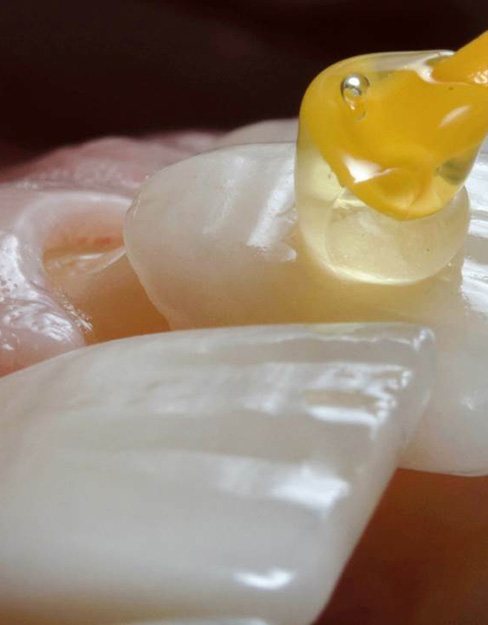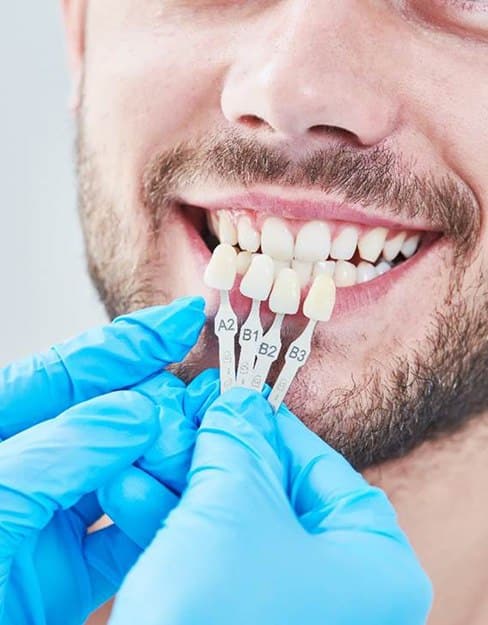Refresh Your Smile with Veneers
Are you self-conscious of teeth that are chipped, cracked, gapped, severely discolored, or slightly misaligned? Whether one or all of these cosmetic imperfections affect your confidence, veneers are a versatile, convenient treatment that can make your smile appear bright, symmetrical, and undamaged.

Dr. Kotlarek and our experienced team at Roman Dentistry customize every treatment based on each patient’s unique needs for precise results that reflect their individual goals for their smiles. If you’d like to learn more about veneers and how they could help make your dream smile a reality, schedule a consultation today!
Why Choose Roman Dentistry for Veneers?

Personalized & Detailed Dentistry

Precise Digital Impression System

Financing Available Through CareCredit

What are Dental Veneers?
Dental veneers are thin sheaths that are made to cover the visible portion of the teeth that everyone can see. They’re typically made from materials like porcelain and ceramic because they can be color-matched to seamlessly blend-in with surrounding teeth and texturized to look like natural tooth enamel.
One convenient aspect about this treatment is that each veneer is custom made for the individual teeth that you’d like to improve the appearance of, so depending on whether you just have one or two damaged teeth, or you’d like your entire smile to get a makeover, this treatment can be highly customized to meet your needs.
The Process of Getting Veneers
When you visit your cosmetic dentist for veneers, you can expect the process to take place over the course of two to three visits to our office. Over the duration of these appointments, here’s what you can expect to happen:
- During the consultation, Dr. Kotlarek will outline a customized treatment plan for you and discuss any questions you may have before moving forward with the process.
- Preparation of Teeth. In order for the veneers to lay flush with the surrounding teeth, a small amount of enamel will need to be removed to prepare the teeth for veneers.
- Placement of Temporary Veneers. Temporary veneers will be placed to protect the prepared teeth.

- Capturing Impressions. Kotlarek will capture digital impressions of the teeth that you’d like to improve with veneers to send off to our lab to have the restorations crafted.
- Crafting Veneers. The veneers will be custom crafted to meet Dr. Kotlarek’s specifications in our trusted lab.
- Placing Veneers. Once the veneers arrive, Dr. Kotlarek will cement them onto the prepared teeth after taking off your temporary veneers.

The Benefits of Veneers
With so many wonderful benefits to offer, it’s no wonder why this procedure is so popular among patients. Here are some of the advantages of choosing veneers:
- They’re stain-resistant
- Lifespan of up to 25 years
- Easy to maintain
- Little to no food restrictions after procedure
- Custom-tailored results
- Minimally invasive
- Improvement of the overall appearance of your smile
If you’d like to learn more about this cosmetic treatment, we invite you to give us a call today!
Understanding the Cost of Veneers
Quality comes with a price in the realm of cosmetic dentistry. When it comes to the cost of veneers, it’s often a worthwhile investment for a stunning Hollywood-worthy smile. However, at Roman Dental, we prioritize your needs. To help you make an informed decision, we’ve outlined the financial details of our cosmetic procedures below. Feel free to review the following information to determine if veneers align with your goals. And should you seek further clarity, don’t hesitate to reach out to our office for more information!

Cost vs. Cosmetic Dentistry: What’s Right for Me?
Achieving your dream smile involves a range of possibilities, each with its unique costs, timelines, and durability. Dr. Kotlarek will conduct a thorough assessment to recommend the most fitting solutions:
- Teeth Whitening – Professional whitening can brighten your smile by up to 8 shades, effectively addressing surface and age-related discoloration. With proper aftercare, results can endure for months or even years.
- Dental Bonding – Minor dental concerns can be resolved through direct bonding, where tooth-colored composite resin blends seamlessly with your enamel. Offering great value, this solution boasts longevity of 5 to 10 years.

- Veneers – Instantly enhance your smile’s appearance by attaching veneers to visible teeth. This minimally invasive option addresses various imperfections swiftly. They’re a cost-effective solution that allows you to avoid multiple treatments, and they can remain intact for a decade or more, delivering long-lasting results.

How to Make Veneers Affordable
Most dental insurance plans do not cover veneers as they are not usually deemed “medically necessary” by insurance providers. Nonetheless, there are alternative ways to make veneers more financially accessible. For example, our dedicated team offers flexible financing via CareCredit. This allows you to pay for your treatment through manageable, low-interest monthly installments. With this approach, you can manage the cost over time rather than in one lump sum.

Veneers FAQs
Are you ready to undergo a complete smile transformation? Although you may be eager to receive your new veneers, there is a good chance that you still have several questions you would like to ask. We expect this and are ready to help you see a new and improved appearance with complete confidence. In fact, many of our patients have inquired about these custom restorations over the years, which is why we’ve made it easy to view our responses to some of the most frequently asked questions about veneers. Review the information below and feel free to call us for additional information.
Veneer placement occurs in two steps – the preparation and the placement. During the preparation phase, you’ll have temporary veneers applied to the surfaces of your treated teeth. This not only protects them but also gives you a glimpse of what your new smile will look like. During this time, you’ll need to avoid hard, crunchy foods like raw vegetables and nuts. You’ll also want to stay away from ice and hard candies. And because your temporary veneers are not made of the same stain-resistant material as permanent ones, they can easily stain if you drink too many dark-colored beverages. Once your finalized veneers are in place, it’s important that you minimize your exposure to the same crunchy foods and dark-colored beverages, as they can cause problems over time. However, you may resume eating normally again.
You may notice that you have a slight lisp when starting your journey with veneers. The reason is that they are foreign to your mouth, so your existing teeth, gums, and tongue must become accustomed to their presence. By taking the time to practice saying certain words and phrases, you will begin to notice a positive change in your ability to speak clearly. Instead of worrying about the sounds you make, you’ll be able to speak confidently and comfortably when surrounded by others.
The number of veneers you will need is based on what you desire from a beautiful smile. Many patients opt to replace as many as 10 or 12 teeth; however, you do have the option to fix only 2 or 3. The choice is yours, but you will want to make sure that your smile appears even and uniform. Symmetry is important when it comes to veneers, so you and your cosmetic dentist will want to discuss what will look best once your veneers are in place. If you find that you have existing teeth that are discolored, but you prefer not to have too many veneers put into place, you can always inquire about undergoing teeth whitening treatment first. This way, your veneers will match the brighter color of your teeth when put into place.
It is possible that your veneers will help to keep your appearance supple. Over time, the elasticity of your facial skin can begin to sag, causing you to appear much older. However, with the help of veneers, not only will the brighter, healthier smile cause you to look younger, but it will also give a bit more definition and volume to your face, which can do wonders for your self-esteem and appearance.








